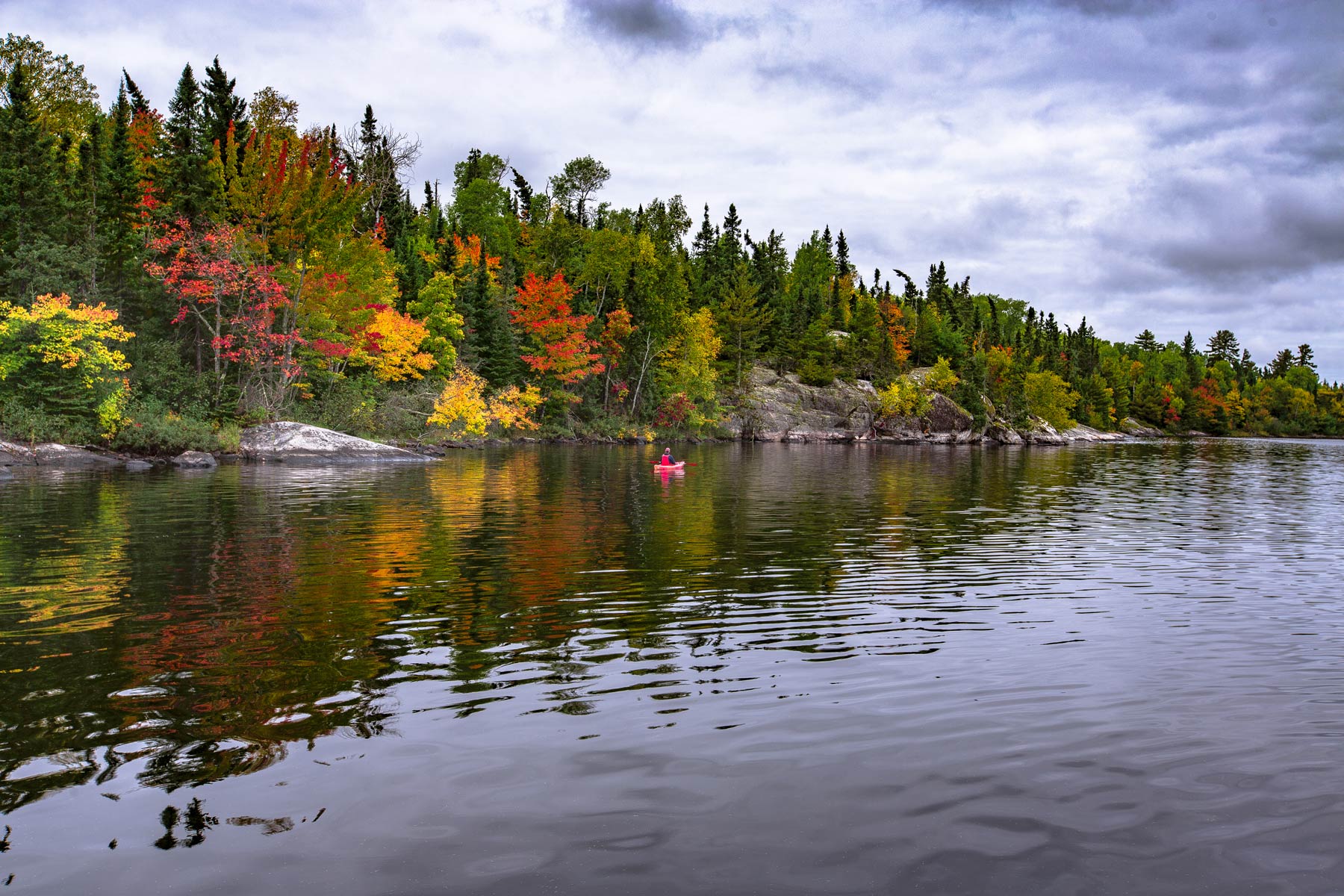
Article Overview: Historic Sites In Minnesota
Historic Sites In Minnesota. More Than Just Parks has 15 incredible must-see sites for you to visit.
I’ve been to so many of these amazing places since retiring from teaching in 2018. Did I mention that I taught history? I spent a lifetime teaching about the history behind these momentous sites. Then I got to see them firsthand. And now I’m sharing the stories of these incredible places with you. It doesn’t get any better than that!
I’m going to give you my list of the 15 Historic Sites In Minnesota that you’ll want to see.
To be clear, this list includes national park sites (as in sites managed by the National Park Service) as well as national parks. It also includes sites not managed by the National Park Service. After all, we’re more than just parks!
If you’re planning a trip to the Land of 10,000 Lakes then one book that I highly recommend is: The Seven States of Minnesota: Driving Tours Through the History, Geology, Culture and Natural Glory of the North Star State by John Toren.
Without further ado, let’s dive in.
Table Of Contents: Historic Sites In Minnesota
Top 15 Historic Sites In Minnesota
15. James J. Hill House

Minnesota is known as the Land of 10,000 lakes, which is the highest number of any state in the United States. It’s also famous for being the home of Mall of America, the largest shopping mall in the United States; and its outdoor activities, including hiking, camping, fishing, and winter activities.
And the state has some amazing historic sites. More Than Just Parks is excited to share our list of the Top 15 Historic Sites In Minnesota with you. And we’re kicking off our list at #15 with the James J. Hill House.
The James J. Hill House is located in St. Paul, Minnesota. It was built between 1891 and 1892 for James J. Hill, a prominent businessman and railroad executive who was one of the wealthiest and most powerful men in the United States during the Gilded Age.
The home was designed by architect Clarence H. Johnston, Sr. and was known for its grand scale, fine craftsmanship, and advanced technological systems.
The James J. Hill House is a significant example of the French Renaissance Revival architectural style and is considered one of the most important and well-preserved homes of the Gilded Age.
It features a three-story stone and brick structure, with a steeply pitched slate roof, dormers, and a central tower. The interior is richly detailed, with intricate woodcarvings, ornate plasterwork, and intricate mechanical systems.
After the death of James J. Hill in 1916, the home was occupied by his family until the 1940s, when it was donated to the Minnesota Historical Society. The house was opened to the public as a museum in 1978 and has been open for tours since.

James J. Hill House | Courtesy of Wikimedia Commons
14. Rabideau CCC Camp
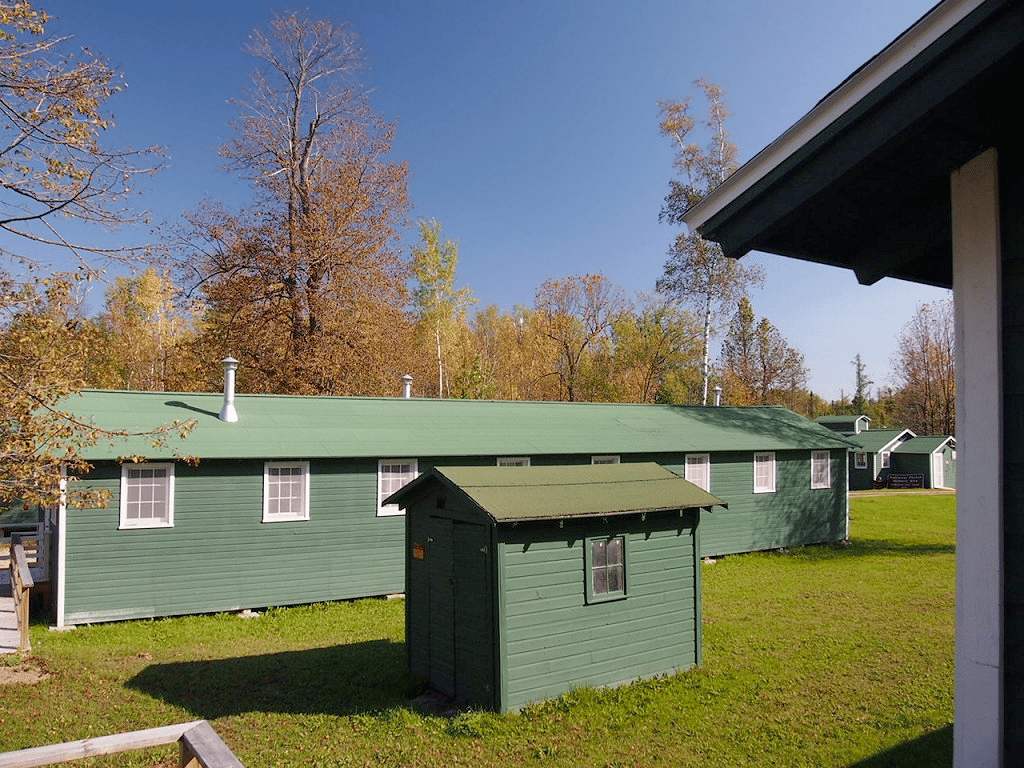
At #14 on our list of the Best Historic Sites In Minnesota is a place which celebrates one of the most successful government programs in American history.
The Rabideau CCC Camp is a historic site that was used as a Civilian Conservation Corps (CCC) camp during the Great Depression in the 1930s.
The CCC was a federal program established in 1933 as part of the New Deal that employed young men to carry out conservation and development projects on public lands. It was located in the Chippewa National Forest in northern Minnesota, and was one of the many CCC camps that were established across the United States during this period.
The camp at Rabideau was established in 1933 and operated until 1942, and was used to provide work and training to young men from the area.
The camp consisted of several buildings, including barracks, a mess hall, administrative buildings, and a recreation hall. The CCC workers at the camp were involved in a variety of projects, including planting trees, building trails and roads, and fighting forest fires.
A National Historic Landmark
The camp was designated a National Historic Landmark in 1992 for its well-preserved condition, it is one of the best-preserved CCC camps in the country. Today, the camp serves as an educational center, where visitors can learn about the history of the CCC and the work that was done at the camp.
It is currently owned by the Chippewa National Forest, which uses the camp to provide educational opportunities and interpretive information to visitors. The camp is open to the public during the summer months, and it offers tours, exhibits, and other programs to help visitors learn about the camp’s history and the legacy of the CCC.

13. Charles A. Lindbergh House
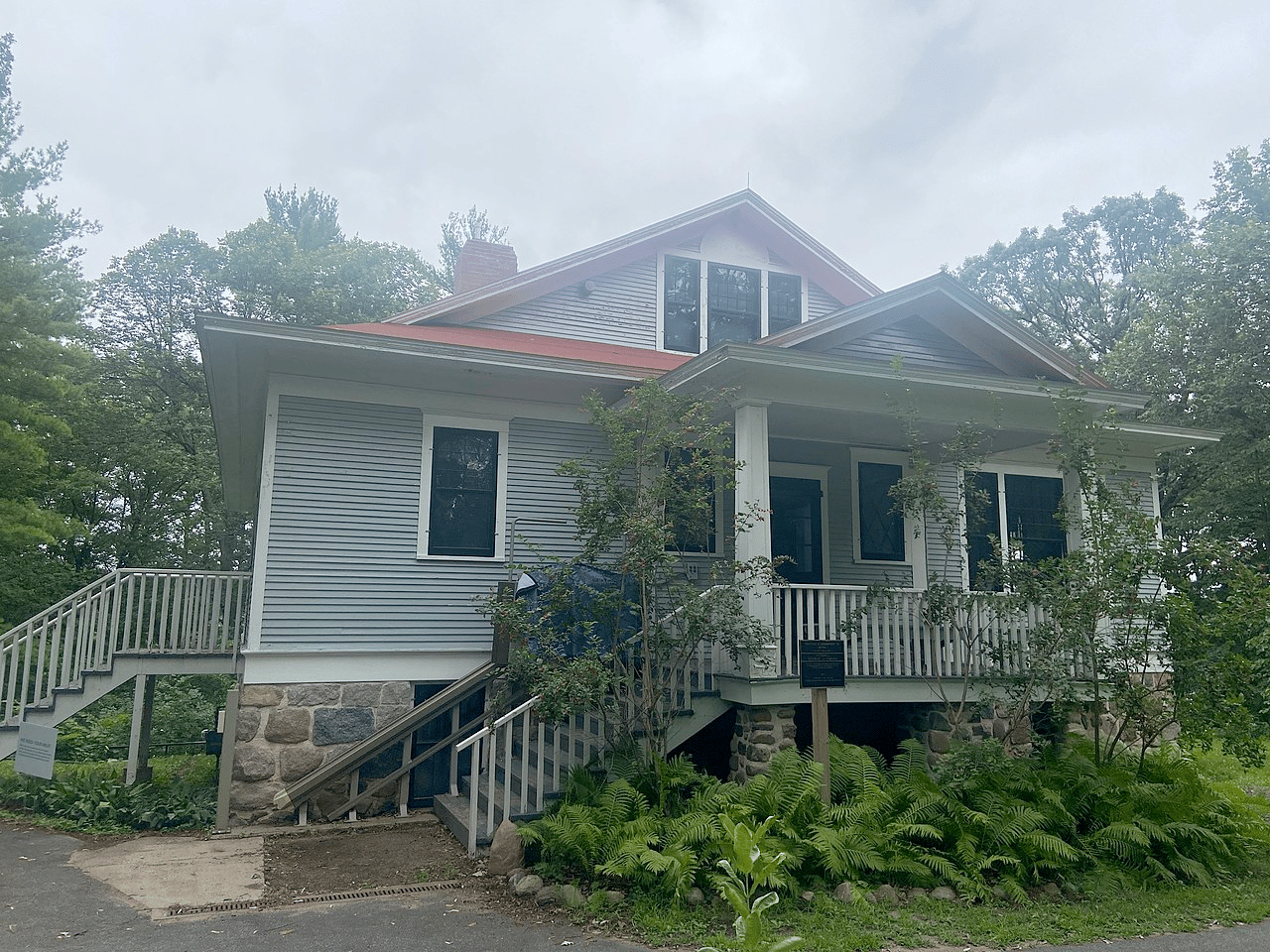
Our next historic site celebrates one of the greatest aviators of all time. Welcome to the Charles A. Lindbergh House.
It’s the childhood home of Charles A. Lindbergh is located in Little Falls, Minnesota.
Charles A. Lindbergh was an American aviator, inventor, and environmental activist who is best known for his historic solo flight across the Atlantic Ocean in 1927. He was born in Detroit, Michigan in 1902, but his family moved to Little Falls when he was a child.
The Lindbergh family home is a two-story, Victorian-style house that was built in 1906. The home is now a museum, and visitors can take a tour to see where Lindbergh grew up and learn about his early life.
The museum features exhibits that highlight Lindbergh’s childhood, including photographs, artifacts, and personal items that belonged to the family.
Learn About Lindbergh’s Experiences In Little Falls
The museum also explores how Lindbergh’s experiences in Little Falls and his time spent on the Mississippi River shaped his character and influenced his later life. Lindbergh had a deep appreciation for nature, and his experiences living on the river likely contributed to his later work as an environmental activist.
The museum includes exhibits on his famous flight across the Atlantic, his inventions, and his environmental activism, which are displayed throughout the home. Visitors can also take a tour of the house and learn about the Lindbergh family’s life and Charles’s early experiences.
The Charles A. Lindbergh Historic Site is open seasonally, usually from May through October, and offers guided tours of the house, an interactive exhibit, and an audio-visual presentation about Charles Lindbergh’s life.
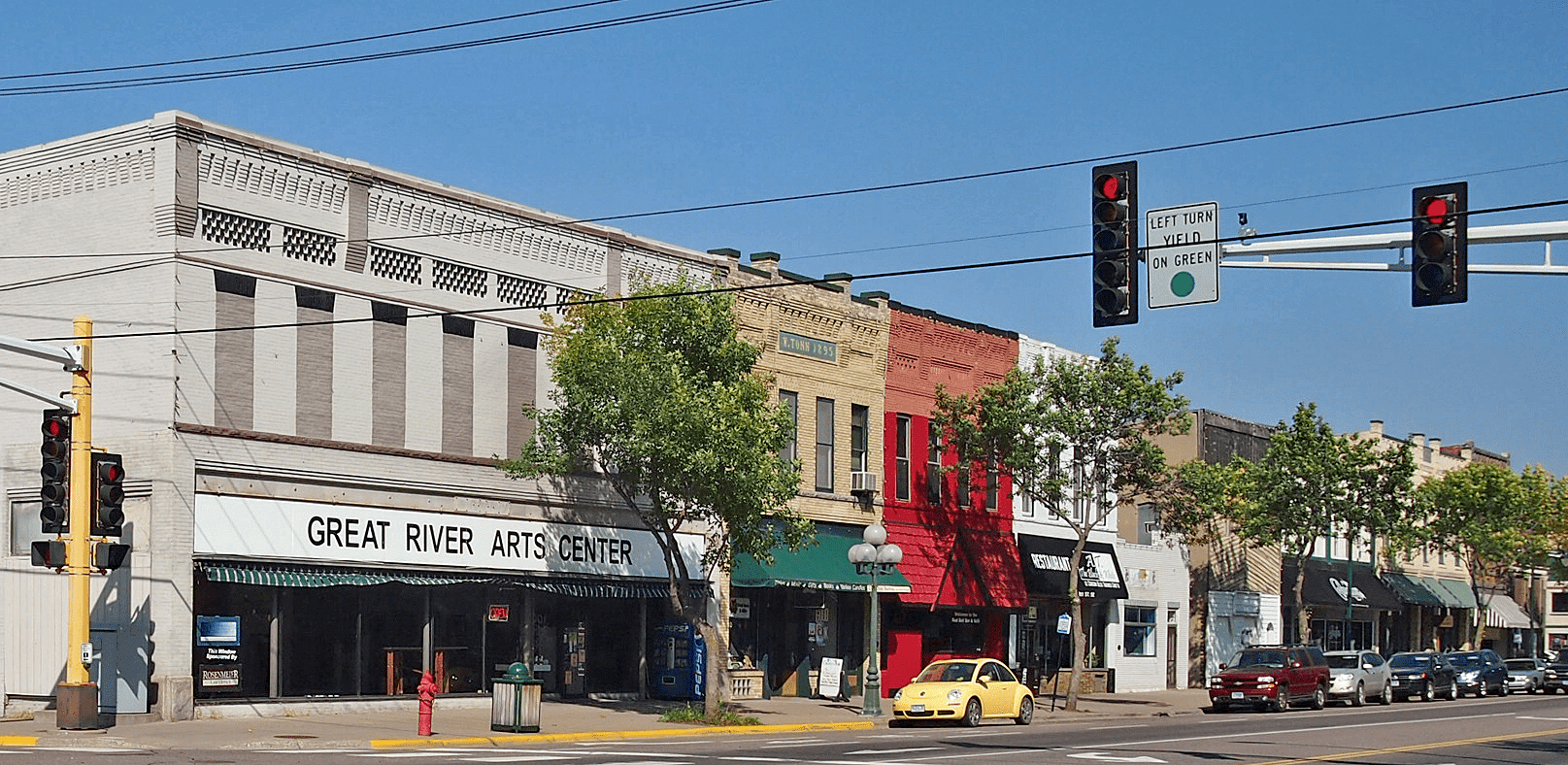
12. Mountain Iron Mine
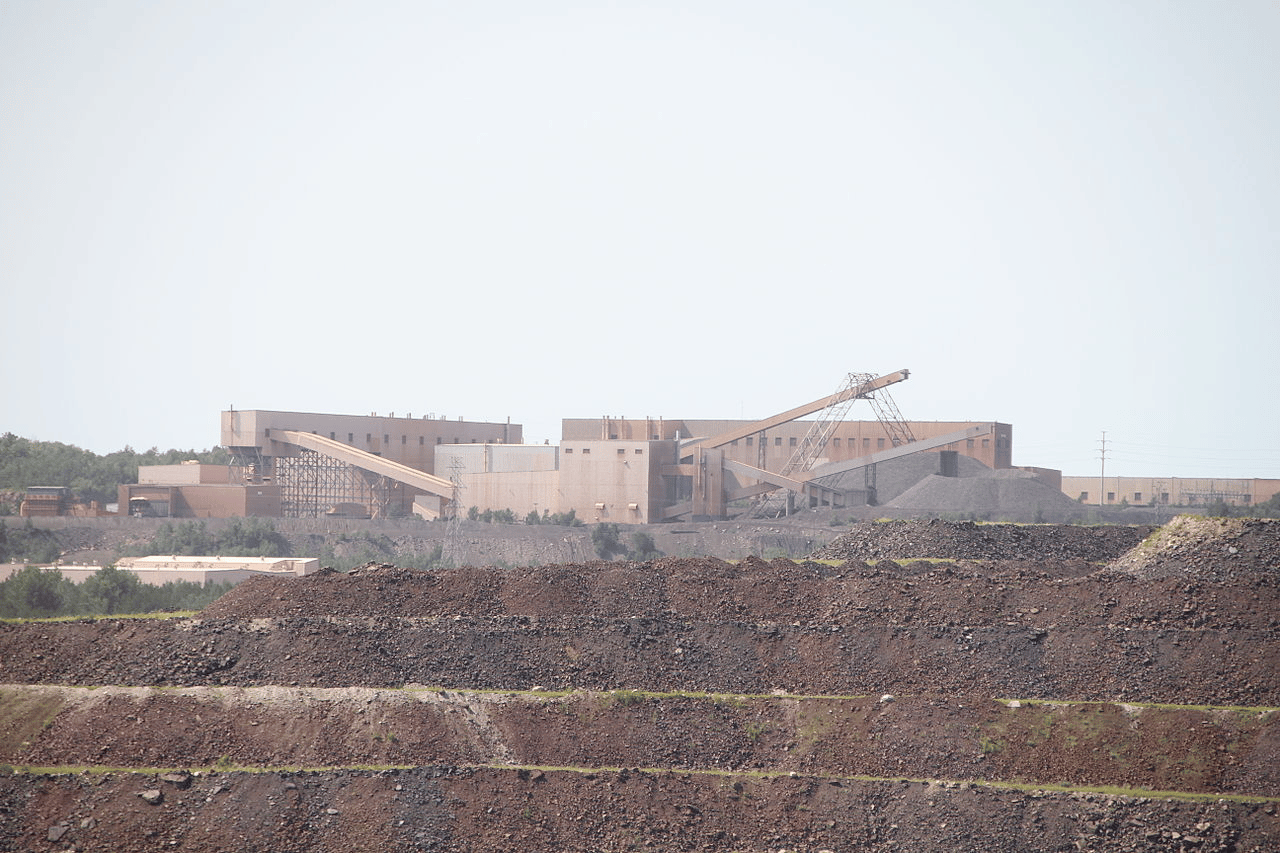
At #12 on our list of the Best Historic Sites In Minnesota is the Mountain Iron Mine.
The Mountain Iron Mine in Mountain Iron, Minnesota was the first mine to open on the Mesabi Range, which is one of the largest iron ore deposits in the United States.
It opened in 1892 and was in operation until 1956. The mine is notable for its historical significance, as it set in motion the extraction of iron ore on the Mesabi Range and helped make Minnesota the largest iron producer in the US and the US the largest steel manufacturer in the world.
The mine was recognized as a National Historic Landmark in 1968 and listed on the National Register of Historic Places for its importance to the industry.
The bottom of the open-pit mine has filled with water and the city maintains an overlook in Mountain Iron Locomotive Park.
Things To Do
- Take a Mine Tour: The highlight of a visit to the Mountain Iron Mine is the underground mine tour. Visitors can ride a train into the mine and learn about the history and techniques of mining.
- Visit the Museum: The Mountain Iron Mine Museum showcases the history of the Iron Range and the mining industry. Exhibits include mining equipment, artifacts, and photographs.
- Walk the Trails: The mine site features a network of trails that wind through the forests and hills of the Iron Range. Visitors can hike, bike, or cross-country ski on the trails, depending on the season.
- Pan for Gold: The mine site offers visitors the opportunity to pan for gold and other minerals. Visitors can learn about the techniques used to extract gold and other minerals from the ore.
- Attend Events: The Mountain Iron Mine hosts a variety of events throughout the year, including festivals, concerts, and special tours.
- Explore the Town: Mountain Iron is a small town that grew up around the mining industry. Visitors can explore the town’s historic buildings and learn about the history of the region.
- Visit Nearby Attractions: The Iron Range region is home to a variety of other attractions, including state parks, museums, and cultural centers. Visitors can explore the region and learn about its history and culture.
- Shop for Souvenirs: The mine site has a gift shop where visitors can purchase souvenirs and mining-related items.
- Learn about Sustainability: The Mountain Iron Mine is now a reclaimed site, and visitors can learn about the efforts to restore the land and promote sustainability in the mining industry.
- Enjoy the Scenery: The Iron Range region is known for its scenic beauty, with forests, lakes, and rolling hills. Visitors can take in the natural beauty of the region and enjoy the peaceful surroundings.

11. F. Scott Fitzgerald House

Next up on our list of the Best Historic Sites In Minnesota is a place which celebrates a literary icon of the Jazz Age. At #11 on our list is the F. Scott Fitzgerald House.
The F. Scott Fitzgerald House, also known as Summit Terrace, is located at 599 Summit Avenue in Saint Paul, Minnesota. It is part of a group of row houses designed by architects William H. Willcox and Clarence H. Johnston Sr. and is listed as a National Historic Landmark for its association with the famous author F. Scott Fitzgerald.
The style of the houses is described as “New York Style” in which each unit has a distinctive character found in some row houses in eastern cities.
The Fitzgerald house is faced with brownstone, is two bays wide, and has a polygonal two-story window bay on the right and the entrance, recessed under a round arch that is flush with the bay front, on the left. The mansard roof has a cross-gable with two round-arch windows and decorative finials.
Architecture critic Larry Millett describes it as “A brownstone row house that leaves no Victorian style unaccounted for, although the general flavor is Romanesque Revival.”
Top 10 Historic Sites In Minnesota
10. Split Rock Lighthouse
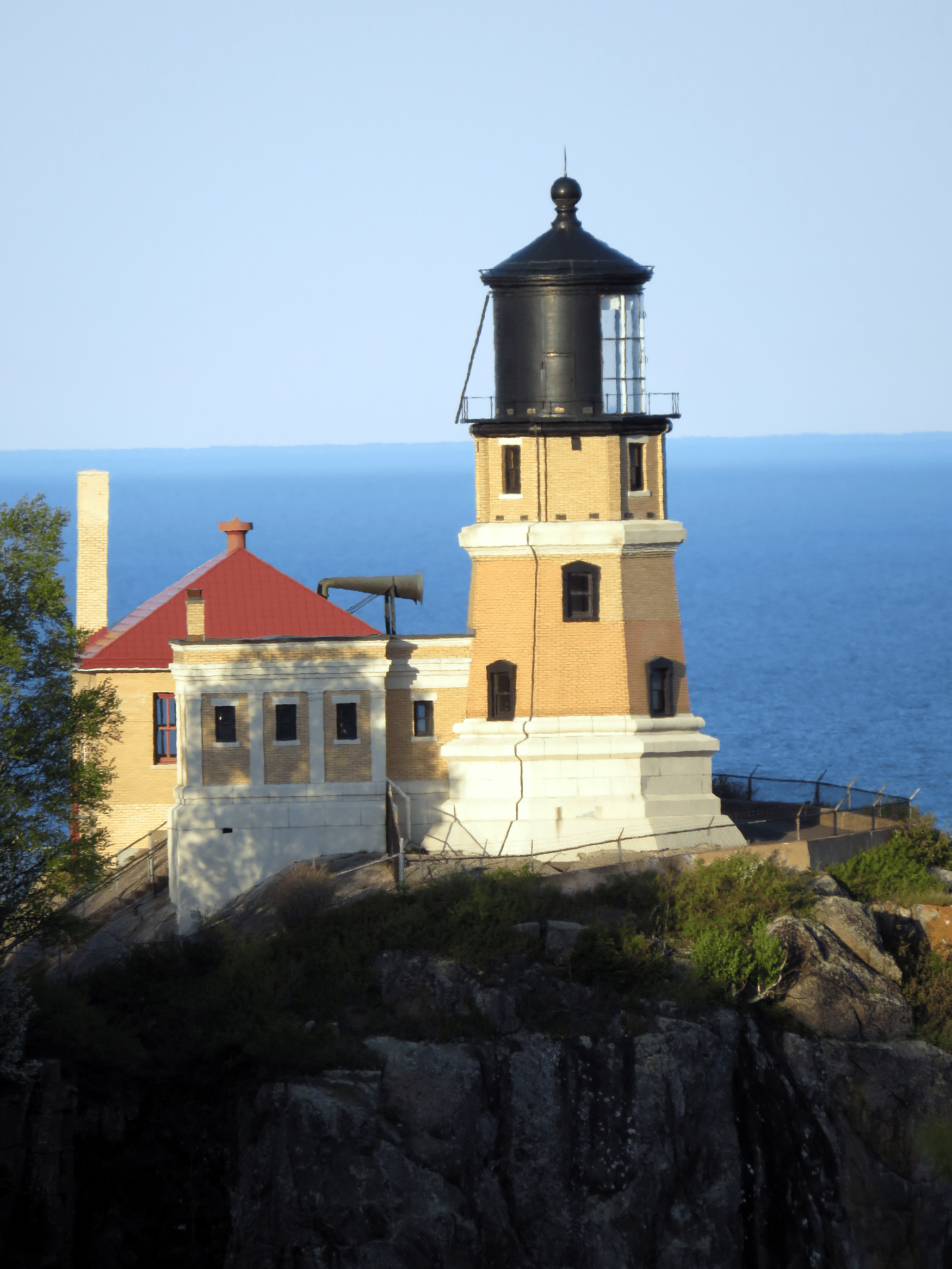
We’re on to our Top 10 Historic Sites In Minnesota. At #10 is the Split Rock Lighthouse.
The Split Rock Lighthouse is located on the North Shore of Lake Superior in Minnesota. It was built in 1910, after a number of shipwrecks in the area prompted the need for a lighthouse to guide ships safely through the treacherous waters.
The lighthouse was in operation until 1969, when it was automated and the resident keepers were no longer needed. It was then added to the National Register of Historic Places in 1971.
During the 1930s, the United States Coast Guard also established a fog signal building and other support structures. The lighthouse and surrounding buildings have been preserved and restored to their original appearance, and the site is now open to the public as a state park.
The park offers guided tours of the lighthouse, as well as exhibits on the history of the area and the lives of the lighthouse keepers. The lighthouse is also available for overnight stays in the summer.
Superior’s Waters Were A Major Shipping Route
In the early 20th century, the Superior’s waters were a major shipping route for iron ore, coal, and grain. However, the rocky shoreline and unpredictable weather conditions made it a dangerous place for ships.
The Split Rock Lighthouse was built to help guide ships through the area safely, and it played a crucial role in preventing shipwrecks and saving lives.
Today, it is an important part of the region’s history and a popular tourist destination, attracting visitors from all over the world.

Points Of Interest At Split Rock
While you’re there, be sure to check out:
- The Lighthouse Keeper’s House: Pay a visit to the lighthouse keeper’s home, restored to its 1920s condition when the light station could only be reached by water. See how the lighthouse keeper and his family made do in one of the harshest and most isolated places in North America, when visitors and fresh supplies were few and far between.
- The Fog Signal Building: The foghorn was used at the first sign of fog, smoke, or snow. Until it was decommissioned in 1969, the fog siren served as an audible warning for ships when inclement weather led to reduced visibility. The foghorn sounds two to three times an hour.
- The Oil House: Explore the building that housed kerosene: the dangerous but crucial oil that fueled the bright-burning lamps. The oil vapor lamps installed at Split Rock were officially visible for 22 miles, though some fishermen claimed to see the beacon from as far away as Grand Marais, more than 60 miles from Split Rock. (Source: Minnesota Historical Society)

CHECK OUT: 25 Bucket List Famous Landmarks In America (MUST-SEE)
9. Saint Croix National Scenic Riverway
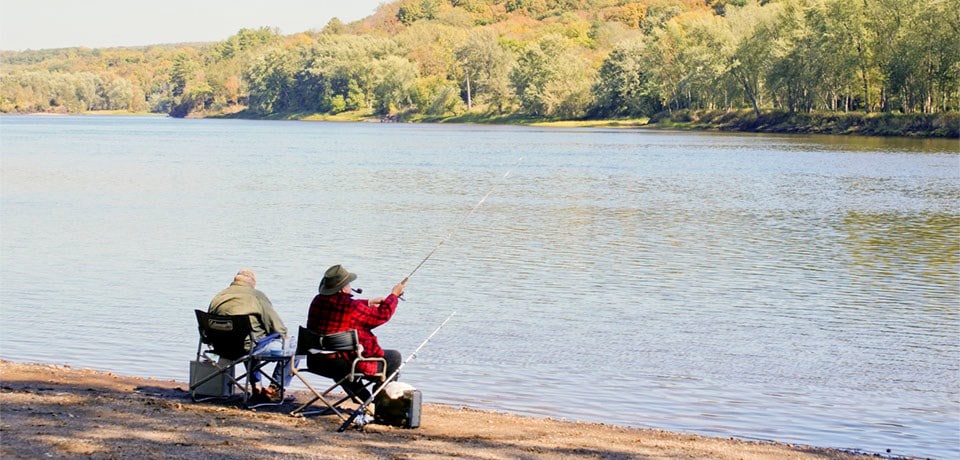
At #9 on our list of the Best Historic Sites In Minnesota is one of the prettiest areas in the state. It’s the Saint Croix National Scenic Riverway.
The Saint Croix National Scenic Riverway is a protected area along the Saint Croix and Namekagon rivers in Minnesota and Wisconsin.
The Riverway was established in 1968 to protect the natural, cultural, and recreational resources of the rivers and their surrounding areas. It is one of the original eight National Wild and Scenic Rivers and is managed by the National Park Service.
The Riverway includes over 250 miles of the Saint Croix and Namekagon rivers, as well as adjacent land along the rivers. The rivers are known for their scenic beauty, including limestone cliffs, hardwood forests, and wetlands. The Riverway also contains a diverse array of wildlife, including eagles, otters, and beavers. The rivers are popular for recreational activities such as canoeing, kayaking, fishing, and camping.
Evidence Of Human Habitation Dating Back Over 10,000 Years
The Riverway also has a rich cultural history, with evidence of human habitation dating back over 10,000 years.
The river and its tributaries have been used by native people for fishing, hunting, transportation, and trade. European settlers also utilized the river as a transportation route and for logging, and the Riverway has many historical sites related to these activities.
The Saint Croix National Scenic Riverway is a unique natural area, known for its clear and clean water, and it attracts visitors from all over the world. With a diverse range of recreational opportunities and natural and cultural resources, it is a popular destination for outdoor enthusiasts and history buffs alike.
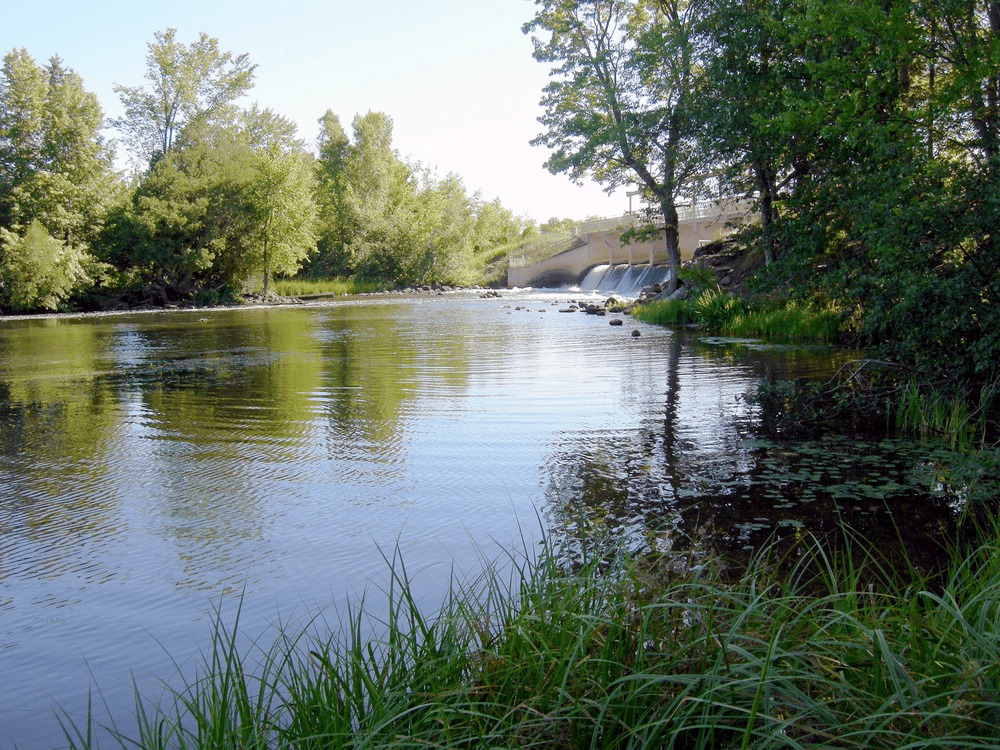
Hiking Trails Along The Saint Croix
There are seven hiking trails which are open year round. Trail surfaces are uneven and may be steep so be sure to watch your step. And also make sure to check for ticks.
Ridge View Trail is a three mile trek with two loops. The Chisage Loop traverses basalt rock outcroppings; the Osceola Loop is more level as you hike through pine and woods. Vistas of St. Croix River backwaters are visible from the bluff side of the trail.
This trail is a great place to see scarlet tanagers, bald eagles, turkey, grouse, and other forest-loving wildlife.
Forest plants include marsh marigolds and large maple trees.
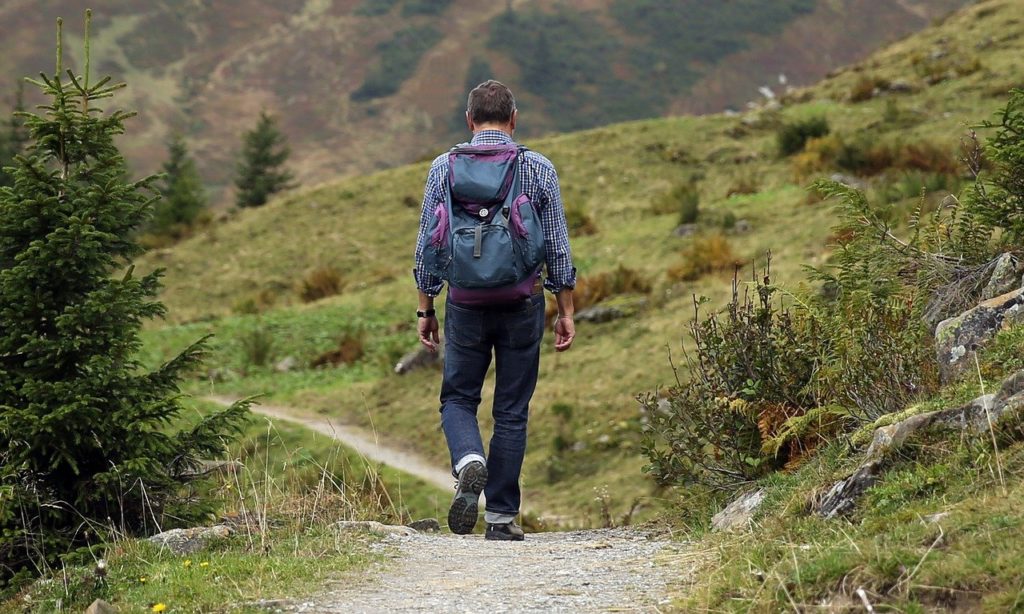
Trego Lake & Trego Nature Trails
The Trego Lake Trail is 3.6 miles and 3 loops. It offers hikers many scenic overlooks of Trego Lake. The area has a large population of white-tailed deer and ruffed grouse. Watch the ground for signs left by these animals.
The Trego Nature Trail is 2.8 miles. Hikers will see a beautiful forest and breathtaking views of the Namekagon River. Wildlife seen can include deer, fox, otters, wolves, and bobcat.

Indian Head Flowage & Sandrock Cliffs Trails
The Indian Head Flowage Trail is a three quarter mile trek. This trail crosses bridged streams as it winds its ways through woods and wetlands to the river.
Hikers will be treated to wildflowers which include marsh marigolds, trilliums, blue flag iris, wild geraniums, and more.
Sandrock Cliffs Trail is five miles and four loops. The lower loop of this trail follows the river closely, then turns onto a ridge providing a variety of terrain and scenery.
The highlight of this trail system is the sandstone cliffs located in a side channel of the river.

CHECK OUT: 10 BEST Revolutionary War Sites In America
8. Pipestone National Monument
Our next historic site is a geologic wonder. At #8 on our list of the Best Historic Sites In Minnesota is the Pipestone National Monument.
Pipestone National Monument is located in Pipestone, Minnesota. The monument was established in 1937 to protect the sacred pipestone quarries, which have been used for centuries by Native Americans to make pipes used in religious and cultural ceremonies. The pipestone found at the quarries is a type of red claystone that is soft and easy to carve, making it ideal for pipe-making.
The monument covers about 367 acres and includes a visitor center that provides information about the history and significance of the pipestone quarries and the pipe-making tradition. Visitors can also take a self-guided trail that leads to the quarries, where they can see the pipestone being quarried and watch demonstrations of pipe-making by Native American artisans.
A Sacred Site For Many Indigenous Tribes
The pipestone quarries have been a sacred site for many indigenous tribes for centuries and it is still considered sacred by many tribes. The quarry is open to visitors, but there are strict rules regarding the removal of pipestone.
Only enrolled members of federally recognized tribes can legally quarry pipestone and it is only allowed for traditional and religious use.
Pipestone National Monument is an important site that is significant to the history, culture and spiritual beliefs of many Native American tribes.
It’s a place where visitors can learn about the history and significance of the pipestone quarries and the pipe-making tradition, and witness the continuation of a cultural practice that has been passed down for centuries.
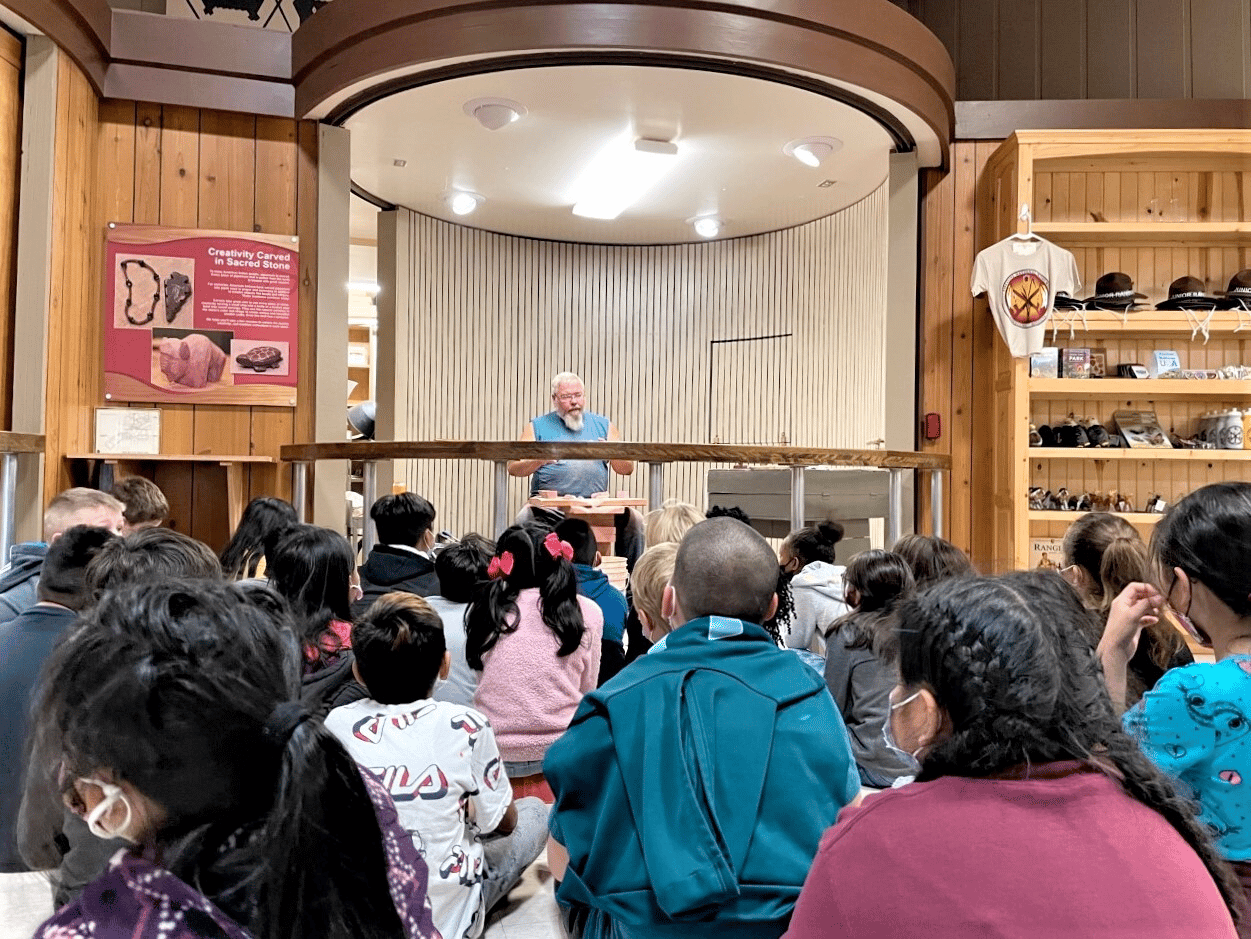
CHECK OUT: 10 BEST Civil War Sites In America
7. North Country National Scenic Trail

Our next historic site is one of the most beautiful scenic trails in the United States. At #7 is the North Country National Scenic Trail.
The North Country National Scenic Trail provides visitors opportunities from bird watching to backpacking. This is another great Minnesota National Park!
The trail traverses eight northern states and connects a host of natural, historic and cultural sites. You can see everything from small towns to larger cities, valleys to hilltops and much more.
The History Of The North Country National Scenic Trail
In 1980, the North Country National Scenic Trail (NCT) was authorized by Congress. It stretches 4,600 miles from upstate New Hampshire to its western terminus at Lake Sakakawea State Park.
The trail actually traversed seven states until 2019 when Vermont was added. The Vermont section is only about 70 miles long.
From the leisurely lake walk of downtown Duluth to the rugged Sawtooth Mountains to the prairies of the Red River Valley to the gentle rolling Laurentian Divide, the North Country Trail offers a cache of contrasting hiking experiences across its roughly 850 miles in Minnesota.
Historic marks include the remnants of iron mining along the Mesabi and Vermilion ranges, Native American historic sites, and remnants of Paul Bunyan’s white pine logging era.
Keep your eyes open wide for iconic Northern wildlife such as loons, moose, whitetail deer, black bear, Canada lynx, timber wolf and bald eagle. (Source: North Country Trail Association)
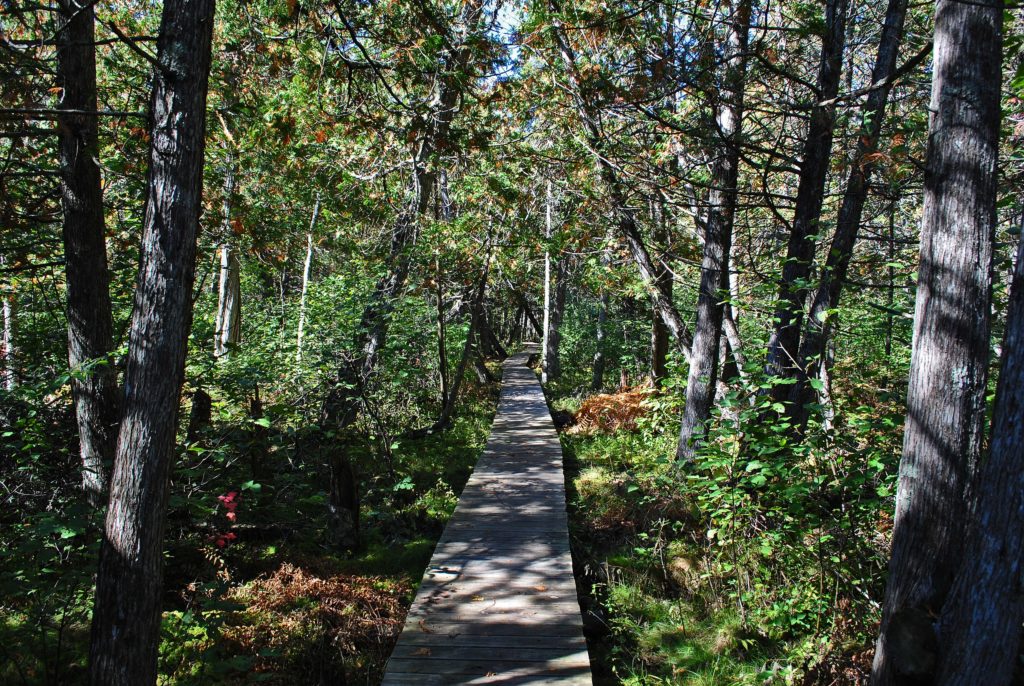
The North Country Scenic Trail In Minnesota
There is a 196-mile, contiguous segment located in north-central Minnesota between Detroit Lakes and Remer and a 400-mile, contiguous segment from near Ely to Jay Cooke State Park south of Duluth.
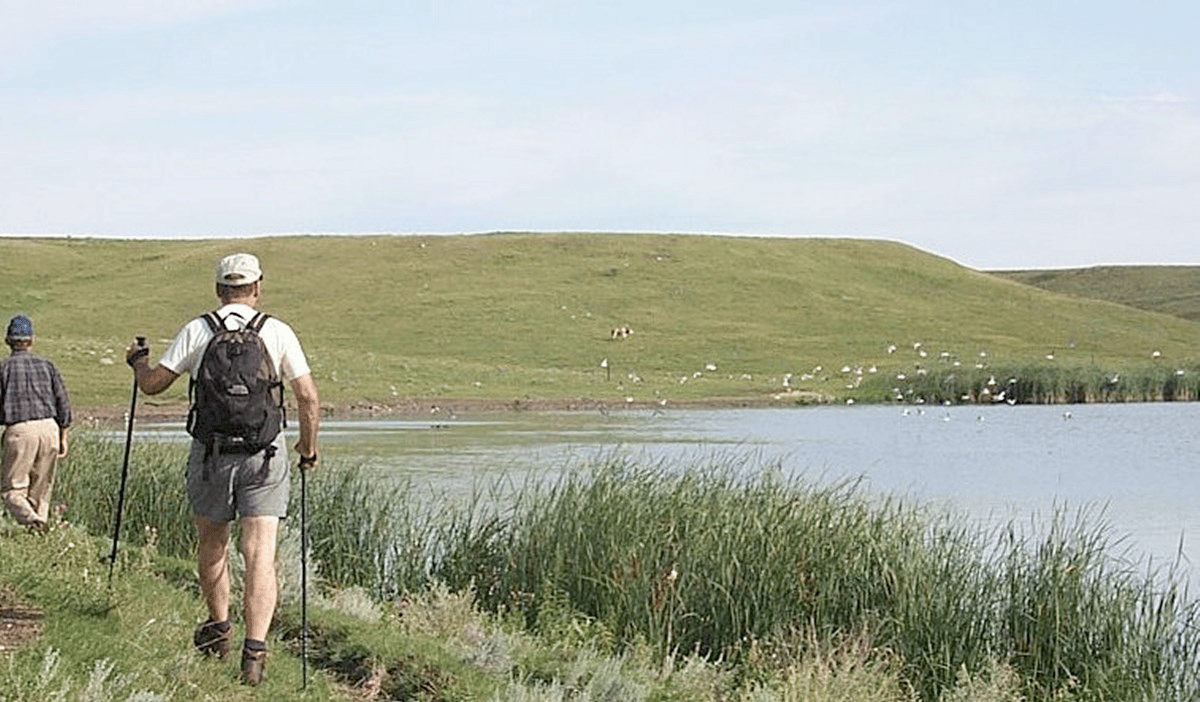
CHECK OUT: A Brief (& Informative) History Of America’s National Park Rangers
6. Mississippi National River & Recreation Area
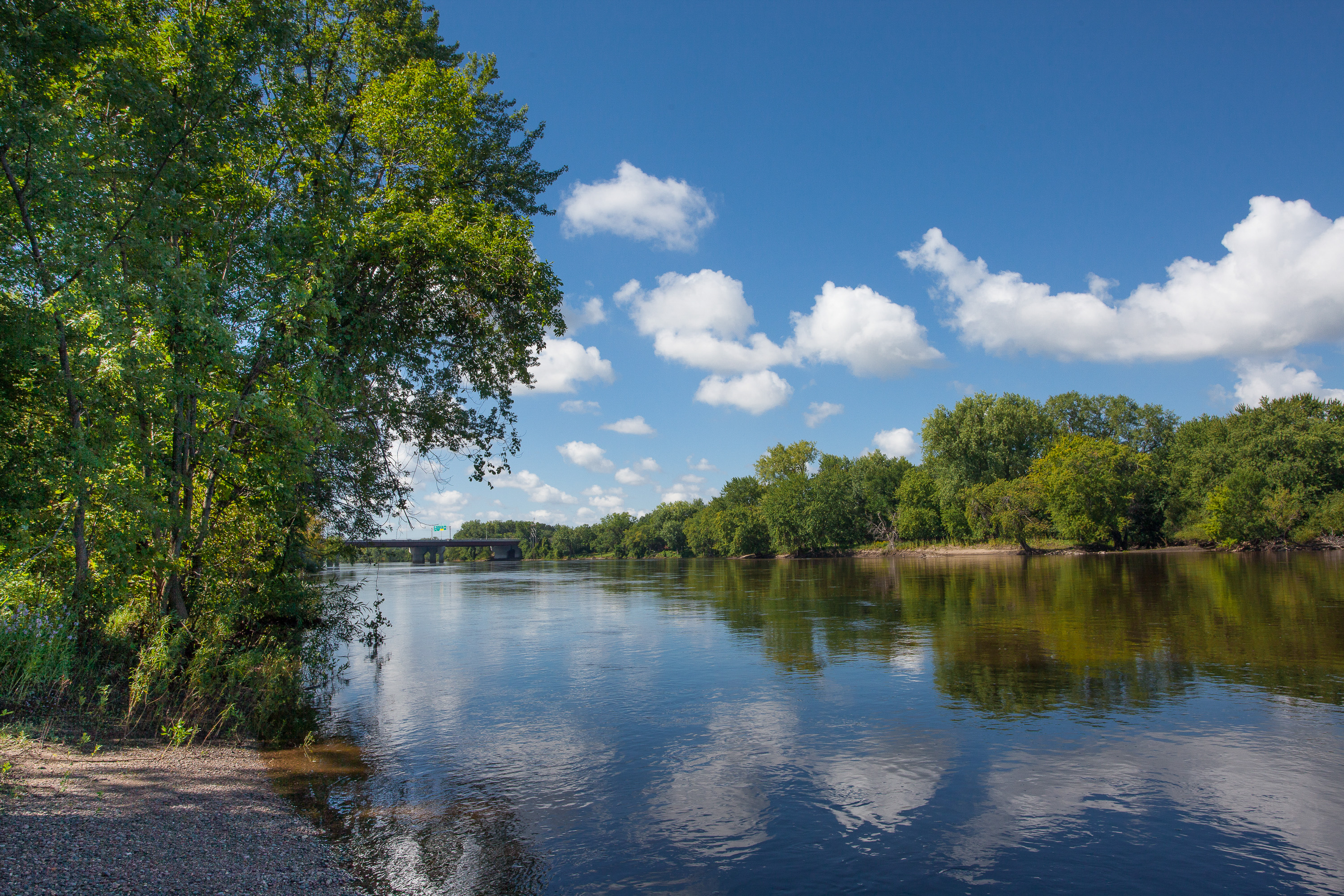
Minnesota has some of the most magnificent scenic recreational areas in the U.S. Our next historic site is a case in point. At #6 on our list of the Best Historic Sites In Minnesota is the Mississippi National River & Recreation Area.
The Mississippi National River and Recreation Area was established in 1988 as a unit of the National Park Service.
The park stretches 72 miles along the Mississippi River in Minnesota, from the cities of Dayton and Ramsey to just downstream of the Minneapolis-St. Paul metropolitan area.
The park was created to preserve and protect the Mississippi River and its associated resources, and to provide recreational opportunities for visitors. It also serves as a way to promote the river’s cultural and historic significance.
The park includes a variety of landscapes, such as bluffs, wetlands, and floodplains, as well as historic sites and recreational areas. It is also a designated National River and a part of the Mississippi National River and Recreation Area.
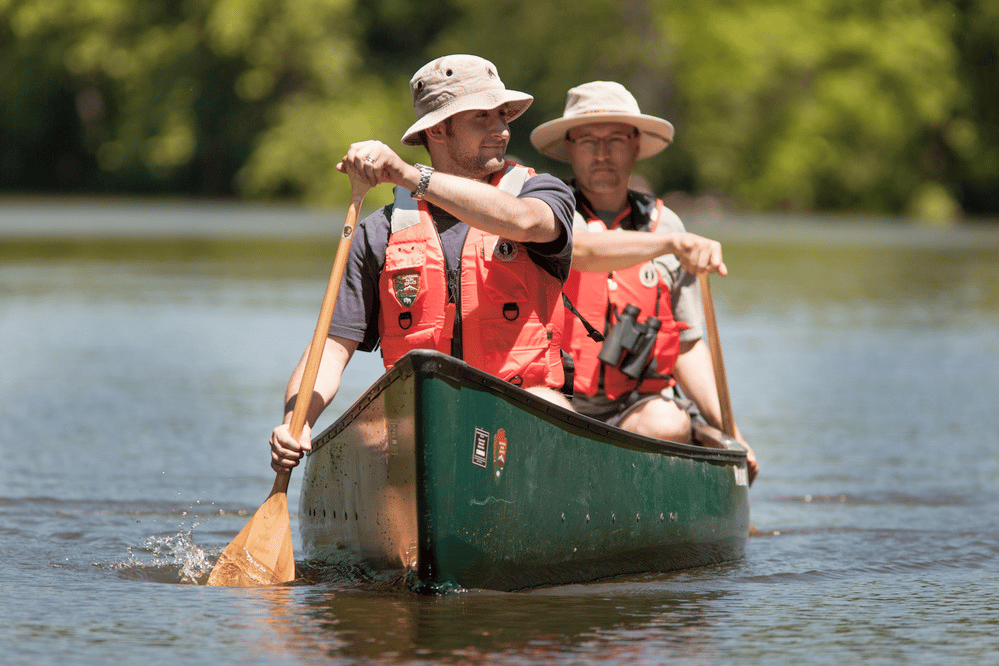
Things To Do
Here are some things you can do:
- Explore the park’s visitor centers: The park has several visitor centers where you can learn about the park’s history, geology, and wildlife.
- Go hiking: The park has several hiking trails that offer stunning views of the river and the surrounding landscape. Some popular trails include the Pike Island Loop, the Indian Mounds Trail, and the Fort Snelling State Park Trail.
- Go biking: The park has many miles of bike trails that are great for cycling enthusiasts.
- Take a boat tour: Several companies offer boat tours of the Mississippi River. These tours provide a unique perspective on the river and its surrounding landscape.
- Go fishing: The Mississippi River is home to a variety of fish species, including walleye, northern pike, and bass. Fishing is allowed in designated areas of the park.
- Go birdwatching: The park is home to a variety of bird species, including bald eagles, ospreys, and great blue herons. The park offers several birdwatching opportunities.
- Visit historic sites: The park is home to several historic sites, including Fort Snelling, the Mill City Museum, and the Guthrie Theater.
- Go picnicking: The park has several picnic areas where you can enjoy a meal with family and friends.
- Attend a ranger-led program: The park offers several ranger-led programs that are designed to educate visitors about the park’s natural and cultural resources.
- Go kayaking or canoeing: The park offers several water trails that are great for kayaking and canoeing. These water trails provide a unique way to experience the park’s natural beauty.
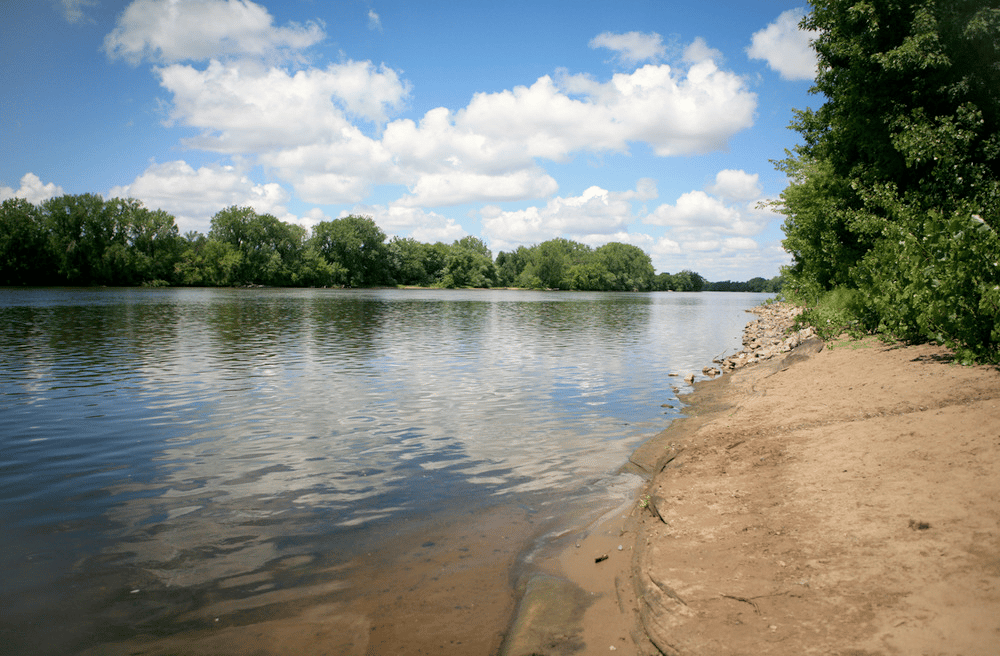
CHECK OUT: 15 MUST-SEE Historic Sites In Mississippi
The Top 5 Historic Sites In Minnesota
5. Grand Mound Historic Site
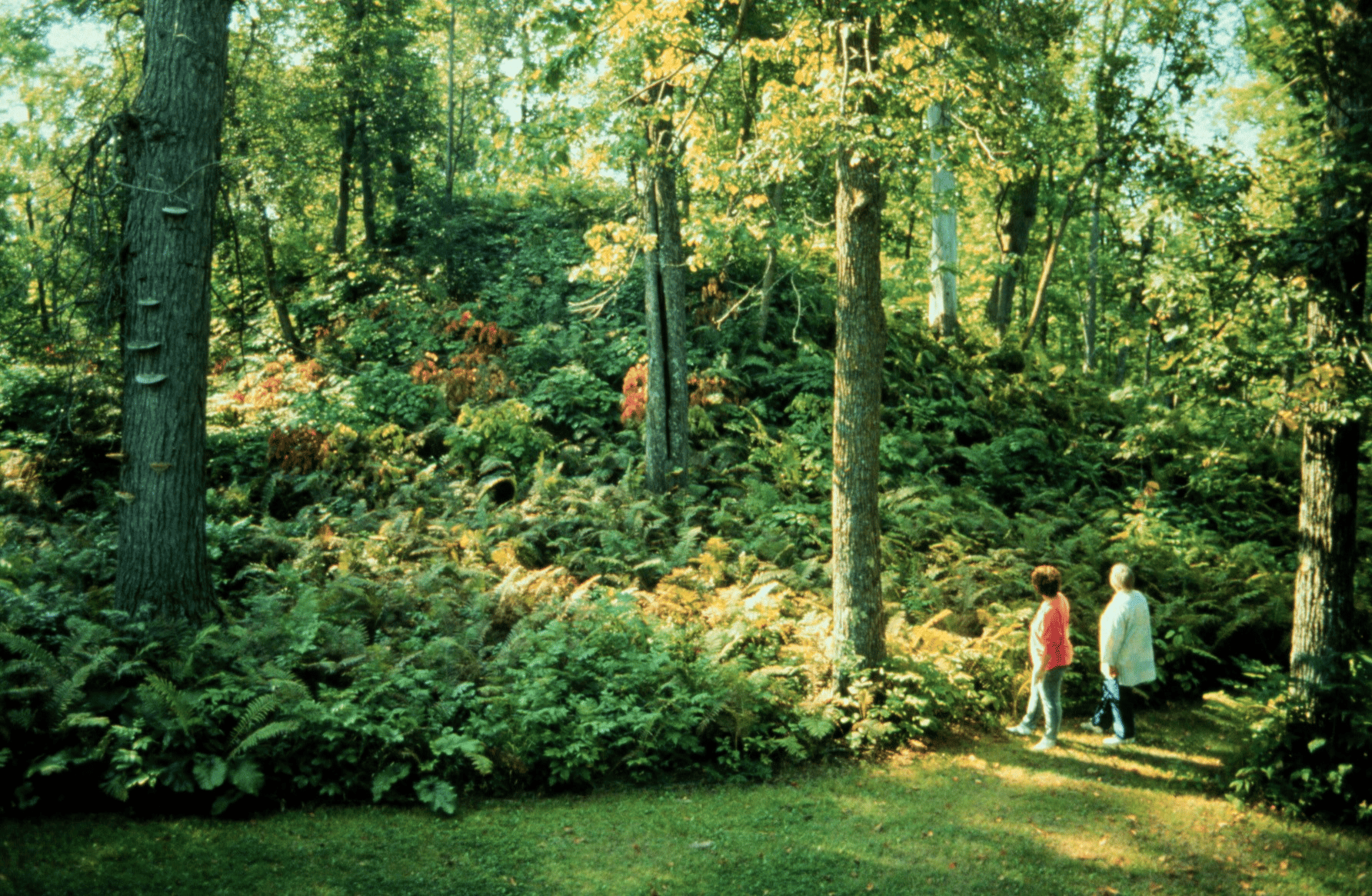
We’re on to our list of the Top 5 Historic Sites In Minnesota. At #5 is the largest prehistoric structure in the Upper Midwest and one of the largest Native American burial sites in the United States. Welcome to the Grand Mound Historic Site.
It’s located along the Rainy River on the Canadian Border and is thought to have been constructed around 200 B.C. by the Laurel, an indigenous people about whom little is known.
It’s A National Historic Landmark
Grand Mound Historic Site is one of 25 National Historic Landmarks in Minnesota.
The largest of the five mounds is 25 feet high and 140 feet long. It is:
- Minnesota’s largest Native American earthwork
- the largest surviving “prehistoric” structure in the Upper Midwest
- the only effigy mound of this type in Minnesota
Some interpret the mound’s unique diamond shape and long “tail” to be a muskrat or serpent. While most mounds were built in high elevations, Grand Mound was built in a floodplain close to the Rainy and Big Fork Rivers.
Grand Mound Historic Site is part of a chain of more than 20 burial mounds that runs for 90 miles along the Canadian and U.S. sides of the Rainy River. (Source: Minnesota Historical Society)
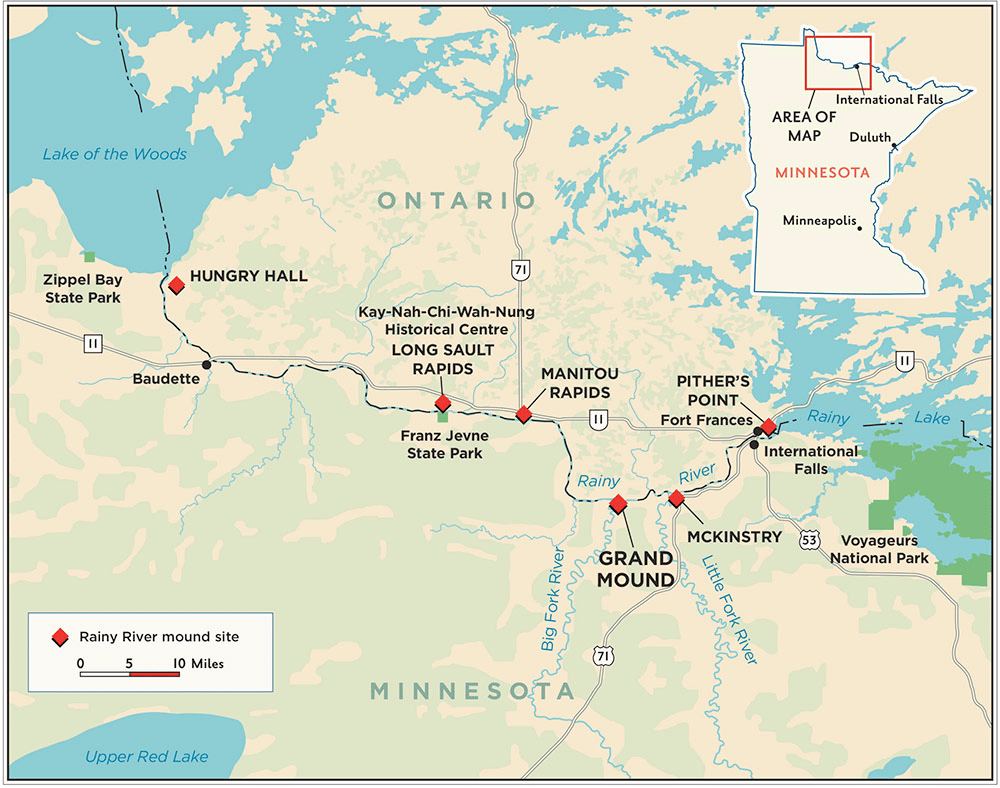
4. Sinclair Lewis Boyhood Home
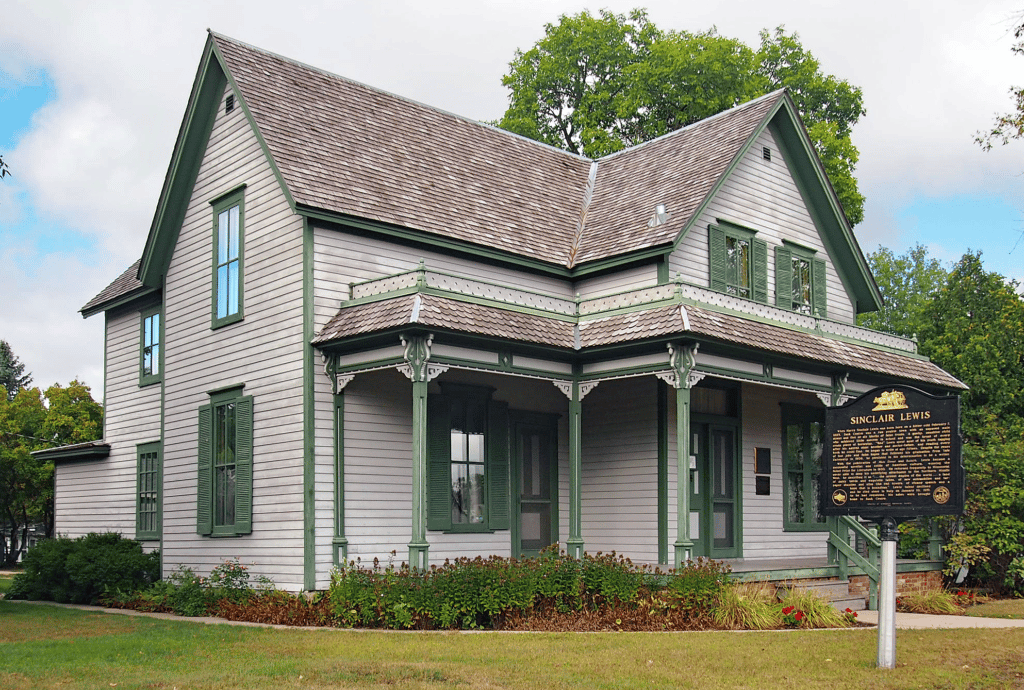
We’re on to our “Final Four.” At #4 on our list of the Best Historic Sites In Minnesota is a historic house located in Sauk Centre, Minnesota. It was the childhood home of Sinclair Lewis, a Pulitzer Prize-winning novelist and one of the most important American writers of the early 20th century.
The house was built in 1883 by Lewis’s parents, Dr. Edwin J. Lewis and Isabel Warner Lewis. It is a two-story frame house with a gable roof, and features Victorian-style architecture.
Sinclair Lewis lived in the house from the age of six until he left for college in 1898. He later wrote about his childhood experiences in Sauk Centre in his novel “Main Street,” which was published in 1920 and became one of his most famous works.
The novel is set in a fictional Minnesota town that closely resembles Sauk Centre, and is considered to be a commentary on small-town life in America.
The Sinclair Lewis Boyhood Home was added to the National Register of Historic Places in 1971 and is now a museum open to the public. Visitors can tour the house and learn about Lewis’s life and works, as well as the history of Sauk Centre. It is also one of the main attraction of the city and is visited by many history enthusiasts.
Take A Deeper Dive
Narrated guided tours are approximately 25 minutes long and take you through the restored turn-of-the-century home where Sinclair Lewis lived with his parents and brothers.
If you’re interested in learning more about this talented author then I recommend: Sinclair Lewis: Rebel from Main Street by Richard Lingeman.
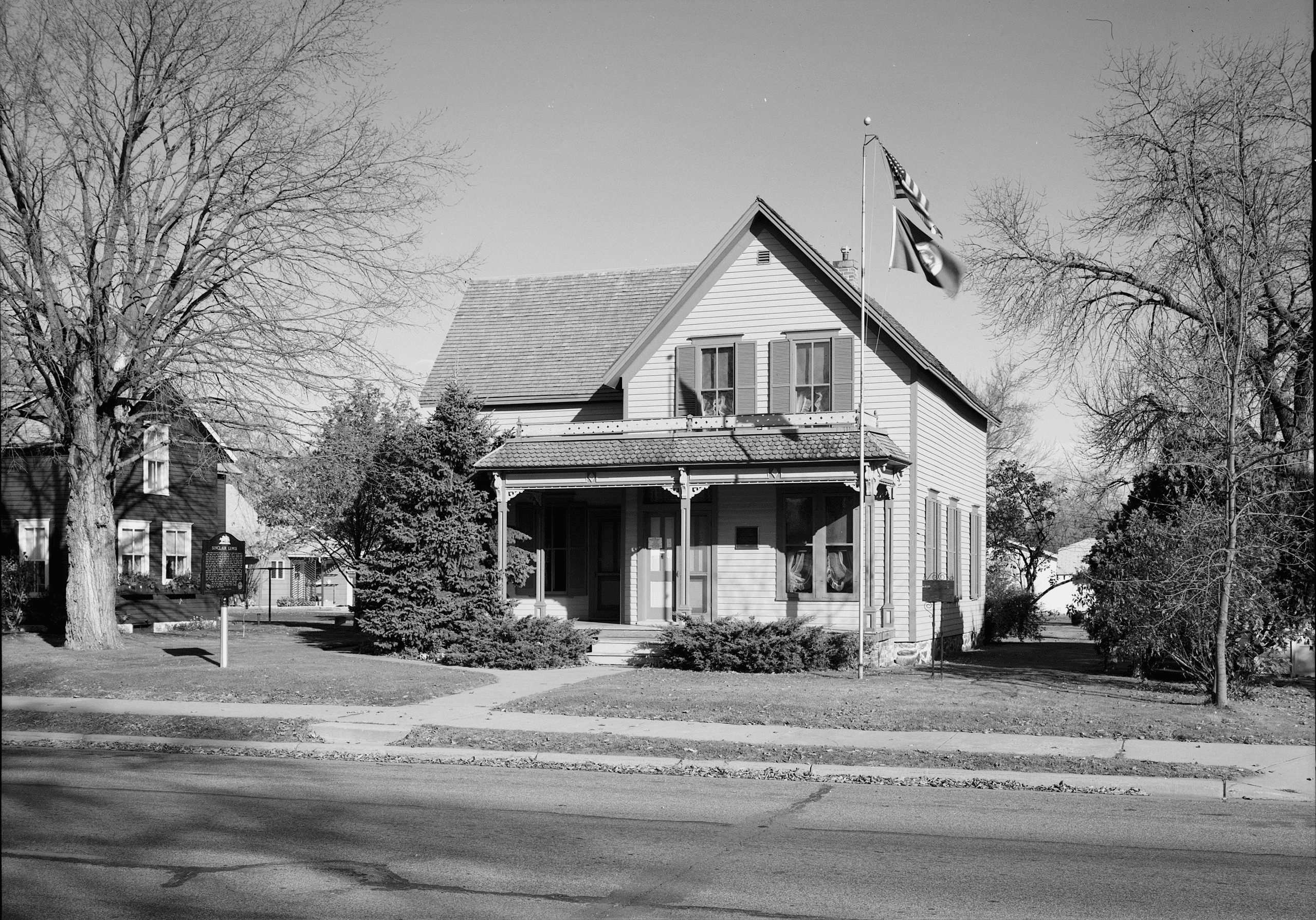
3. Fort Snelling
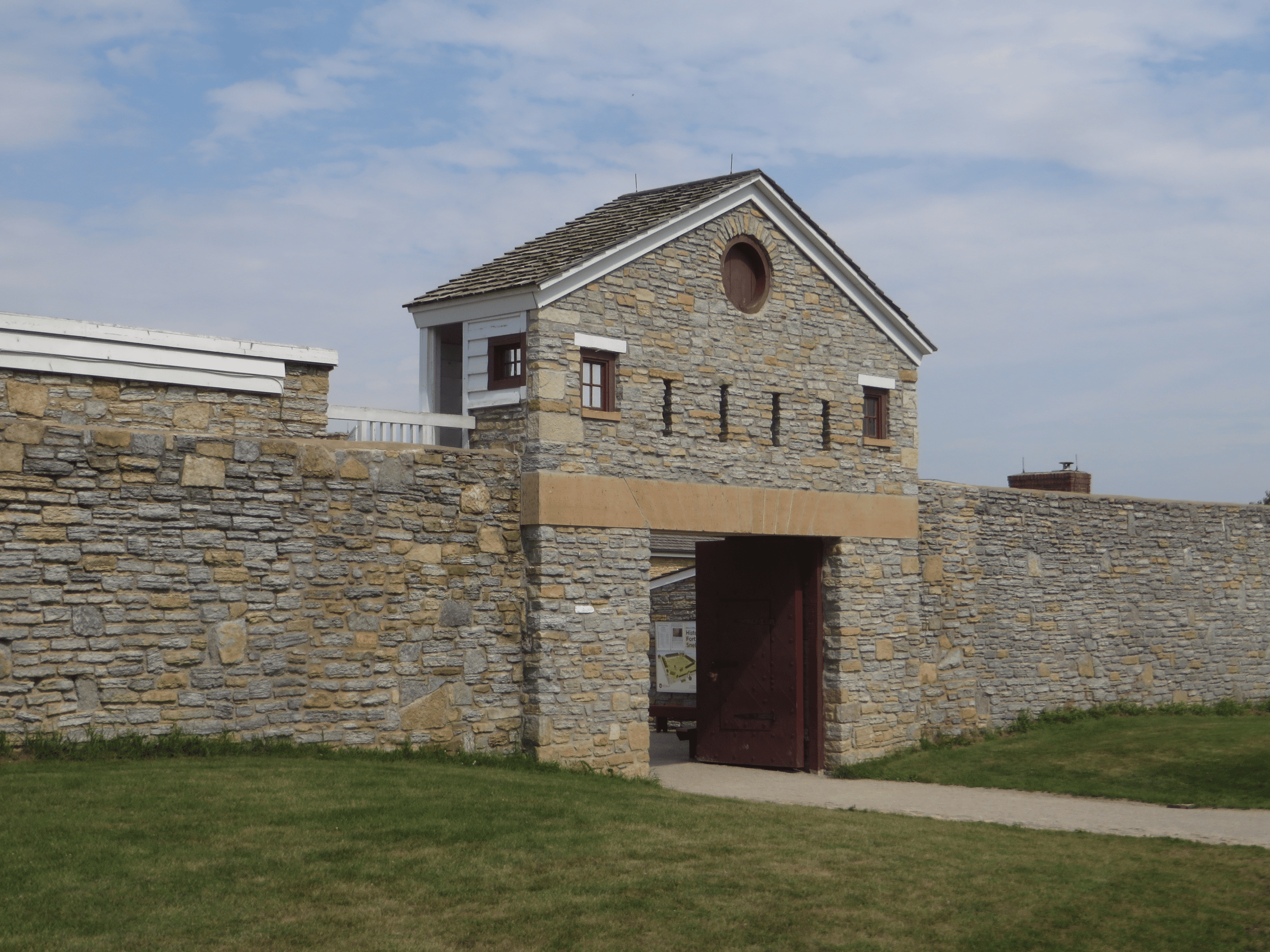
If you love military history then you’ll enjoy our next site which is #3 on our list. Welcome to Fort Snelling. It’s a National Historic Landmark which resides on Dakota homeland, known as Bdote, with history spanning 10,000 years.
The fort was built in the 1820s and originally called Fort St. Anthony, after the falls just upstream on the the Mississippi. It was originally constructed as a military outpost to protect the region’s significant fur trade and, ultimately, had a role in the United States’ war with the Dakota people.
The Minnesota Historical Society now runs the fort, located atop a bluff along the river.
The Minnesota Department of Natural Resources runs Fort Snelling State Park, protecting the land at the bottom of the bluff.
Visitors to the site can learn the stories of the military fort and its surrounding area, which is home to a wide history that includes Native peoples, trade, soldiers and veterans, enslaved people, immigrants, and the changing landscape.
2. Grand Portage National Monument

We’re on to our final 2 historic sites. In the runner-up spot at #2 is the Grand Portage National Monument.
The Grand Portage National Monument is a historic site located in northeastern Minnesota. The monument commemorates the historic Grand Portage, which was a critical trade route used by Indigenous people and fur traders during the late 17th and early 18th centuries.
The Grand Portage trail was an important link between the Great Lakes and the interior of North America. It allowed traders to bypass the treacherous waters of Lake Superior and the Pigeon River, which marked the border between the United States and Canada.
The monument consists of a reconstructed fort, a stockade, and several other historic buildings. Visitors can explore the grounds and learn about the history of the fur trade, the life of the Ojibwe people, and the challenges faced by early settlers in the region.
One of the highlights of the monument is the Grand Portage National Historic Site, which includes a reconstructed trading post, a fur press, and a canoe warehouse. Visitors can watch demonstrations of traditional fur-trading activities, including the preparation of animal pelts and the loading and unloading of cargo.
The monument also includes several hiking trails, which allow visitors to explore the surrounding wilderness and enjoy stunning views of Lake Superior and the surrounding landscape.
Some Wonderful Activities
The monument preserves 710 acres which includes: the historic depot (71 acres) located on Lake Superior, the site of Fort Charlotte (98 acres) on the Pigeon River with the Grand Portage (541 acres) connecting the two depots. The 8.5 mile portage corridor and Fort Charlotte (639 acres) contain the majority of the Monument’s semi-wilderness setting.
There are some wonderful activities for visitors which include:
- Heritage Center and Historic Depot: It’s a great place to begin your adventure. There you can view exhibits about Anishinaabe (Ojibwe) culture and where you learn about a time when the fur trade dominated North American commerce.
- View One Of The Excellent Films On The Grand Portage Story: There’s a feature film (23 minutes) titled “Rendezvous With History A Grand Portage Story,” as well as shorter films which include: “Our Home: The Grand Portage Ojibwe,” “The Gift of the Birch Bark Canoe,” “A Gap in the Hills: Geography of Grand Portage,” and “The Men of the North West Company” – Running time for all four is 24 minutes.
- Visit The America’s National Parks Bookstore.
- Visit The Historic Depot: It includes three reconstructed post and sill log buildings and four outside areas.
- Hike The Mount Rose Loop Trail: Visitors will be treated to a stunning overlook of the historic depot, Grand Portage Bay, Mount Josephine, and the gap in the hills where the Grand Portage footpath goes.

1. Voyageurs National Park
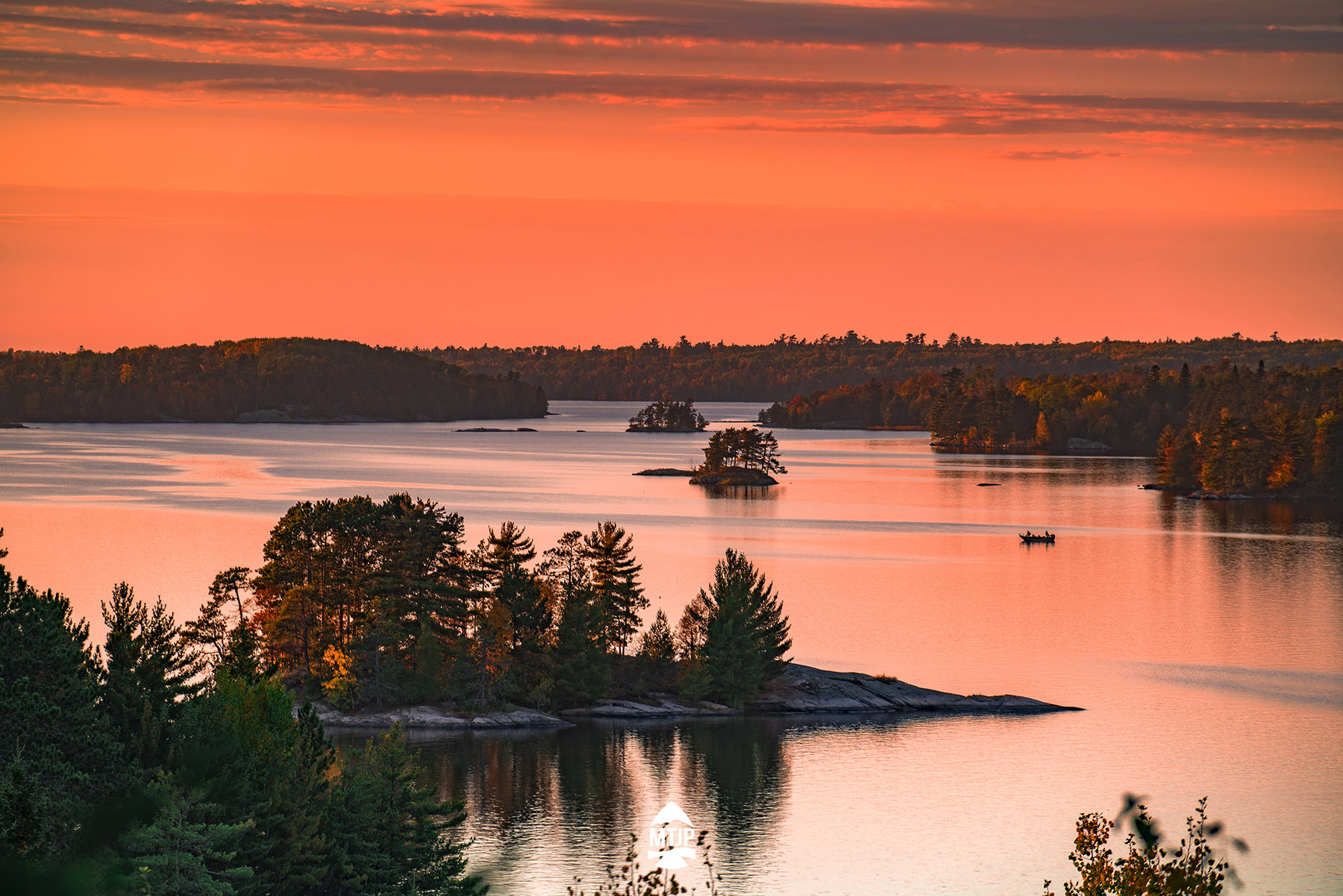
As the #1 Historic Site In Minnesota, More Than Just Parks has selected one of our favorite national parks – Voyageurs National Park.
From kaleidoscopic sunrises and sunsets mirrored on glassy waters of its lakes to some of the most spectacular displays of the northern lights you’ll find anywhere on earth, Voyageurs National Park is a true monument to the wonders of nature.
If you’re wondering how challenging it is to visit Voyageurs given that it’s almost exclusively accessible by boat – don’t!
The area has countless lodges and outfitters that will rent you any kind of boat you could want from a canoe on up to a houseboat at very reasonable prices.
The park is extensively mapped and easy to navigate once out on the waters. Trust me, you won’t want to miss out on an unforgettable experience because you’re unfamiliar with boating.
Check out our complete article on the 10 Best Things to Do in Voyageurs National Park
The History of Voyageurs National Park
Voyageurs National Park has a rich history of human habitation and culture. The area has long been home to the Ojibwe people who made their lives in this harsh, yet bountiful environment. Native Americans called this place home for thousands of years, fishing, hunting, and traveling the lakes in birch bark canoes.
The first Europeans to arrive were early trappers and fur traders known as Voyageurs. These Voyageurs were French Canadians who transported furs using canoes. It was these early frontiersmen for whom the park was named.
Later the park experienced a brief gold rush and a logging boom before finally becoming the recreation paradise it is today. You can read more about the park’s history on their website here.
Save The Boundary Waters
Right now Voyageurs National Park and the Boundary Waters face the threat of permanent despoilment from mining interests looking to exploit the area for metals located beneath the lakes and rivers, namely the Twin Metals Mine.
You can do your part to help save this precious wild area by visiting or donating to Save The Boundary Waters here.
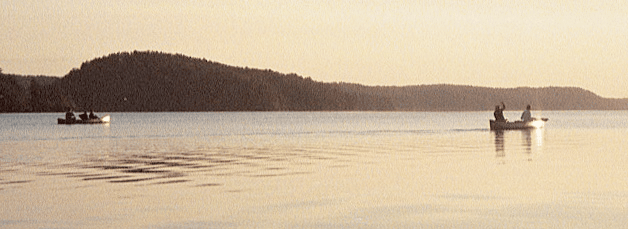
Best Things to Do in Voyageurs National Park
1. Paddle in a Canoe
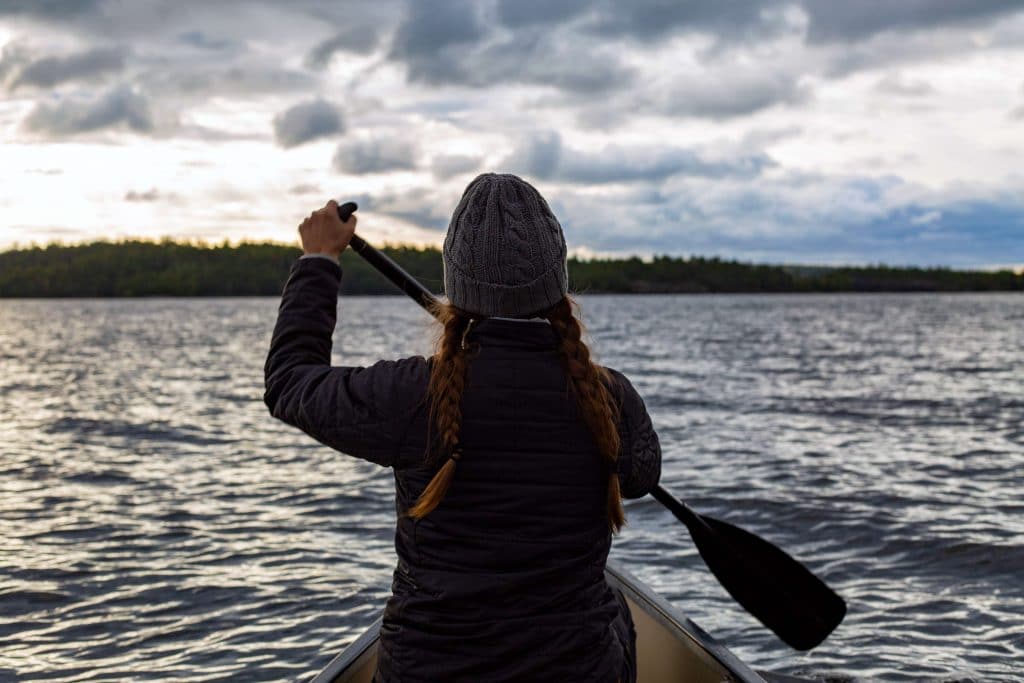
“There is magic in the feel of a paddle and the movement of a canoe, a magic compounded of distance, adventure, solitude, and peace.”
-Sigurd Olson
The best and only way to experience Voyageurs is by boat, but for a truly authentic experience try your hand at canoeing for a day, or if you’re experienced, plan a multi-day trip.
Canoes are the historic mode of transportation in this area and slowly plying the waters of the park’s lakes in a canoe can help give you a fuller appreciation of this unique north woods environment.
2. See the Northern Lights
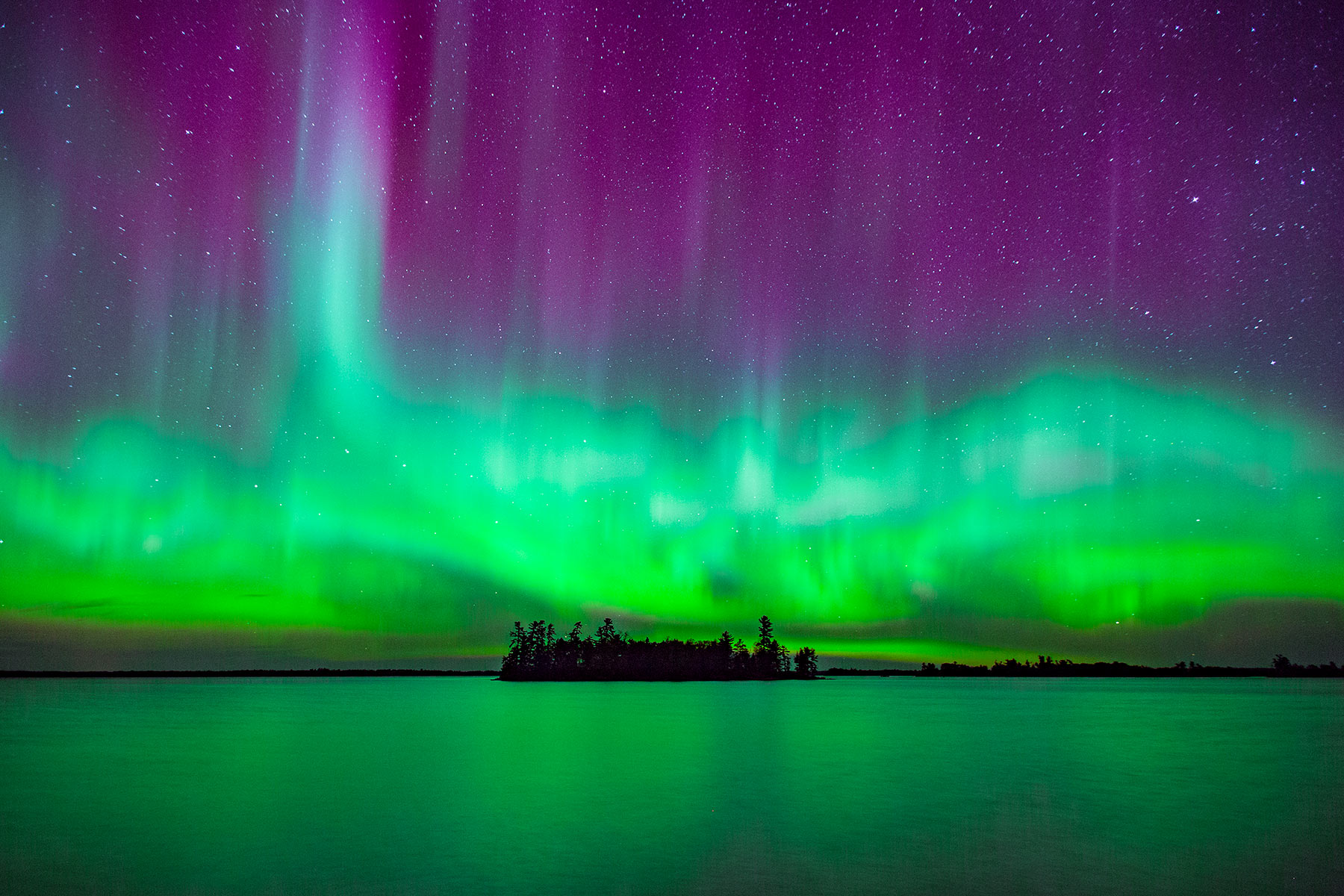
On clear nights in Voyageurs you can see one of the most spectacular light shows in the world, the northern lights. They start as a faint glow on the horizon before working their way up the sky, dancing in real time right before your eyes.
Here in the remote north woods there is almost no light pollution whatsoever and the night sky is truly a wonder to behold.
There’s no need to go to Iceland or Norway or even Alaska if it’s the northern lights you seek, you’ll find them here in all of their glory.
Fall and winter give you your best chances of seeing the northern lights, but you may be lucky enough any time of year if the conditions are right.
3. Explore Ellsworth Rock Gardens

This incredibly unique garden features countless works of art made entirely out of stone. Some of the stones are massive monoliths balanced delicately upon other stones.
This incredible attraction is entirely the work of one man, a humble carpenter from Chicago named Jack Ellsworth, who built these amazing works of art over the course of 20 years starting in the 1940’s.
Tie off your boat here along the shores of Lake Kabetogama and explore the fascinating artistic expressions of one determined man.
4. Go Fishing
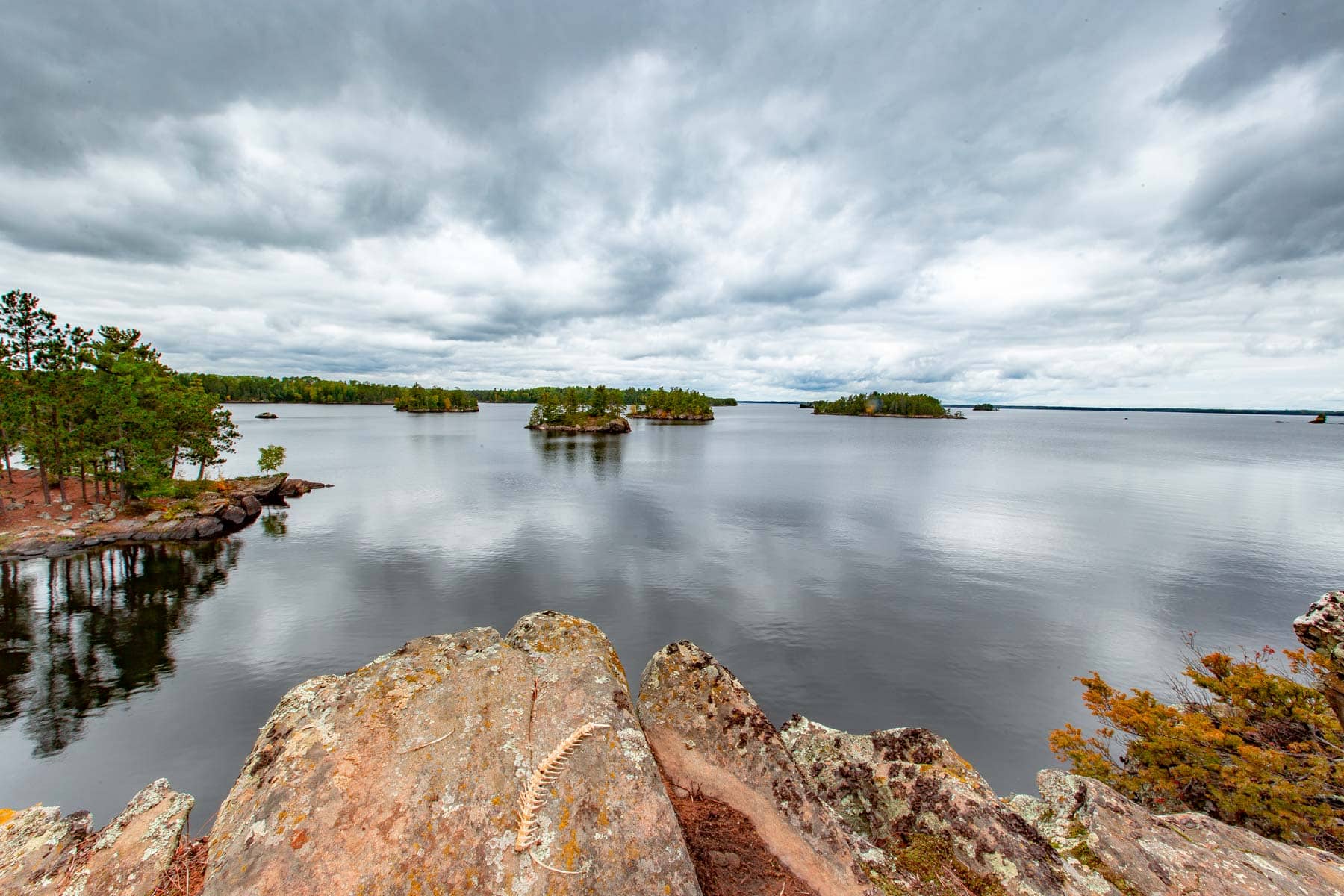
The waters of Voyageurs National Park and the surrounding areas are teeming with native fish that are great for eating or just for sport.
There’s nothing quite like the feeling of catching your own meal and cooking it over an open fire on an island all to yourself.
Be sure to follow NPS and Minnesota DNR rules governing fishing in the area and fish responsibly.
5. Camp on Your Own Island

In Voyageurs there are no campgrounds with sites plotted next to each other one after the other with whirring RV generators, yelling kids, and barking dogs.
In this one-of-a-kind national park every campsite is all to itself, and yes, some are even on their own entire island. Did I mention there are over 150 campsites?
See our full article on Camping in Voyageurs National Park
Watch Our Award-Winning Voyageurs National Park Video
This film is the culmination of several weeks spent in the northernmost region of Minnesota known as Voyageurs National Park. Encompassing more than 340 square miles, Voyageurs is a watery wonderland almost exclusively accessible by boat.
Journey with us as we explore a land blanketed in pristine lakes, erupting with kaleidoscopic fall colors, and home to the most spectacular displays of the northern lights on the planet. This is Voyageurs. Filmed primarily in stunning UHD 8K.
List Of Historic Sites In Minnesota
- Voyageurs National Park
- Grand Portage National Monument
- Fort Snelling
- Sinclair Lewis Boyhood Home
- Grand Mound Historic Site
- Mississippi National River & Recreation Area
- North Country National Scenic Trail
- Pipestone National Monument
- Saint Croix National Scenic Riverway
- Split Rock Lighthouse
- F. Scott Fitzgerald House
- Mountain Iron Mine
- Charles A. Lindbergh House
- Rabideau CCC Camp
- James J. Hill House
Why Trust Us About Historic Sites In Minnesota?
We’re Jim Pattiz and Will Pattiz, collectively known as the Pattiz Brothers and we absolutely LOVE the national parks.
You should probably know that we don’t just make this stuff up out of thin air. We’ve spent our entire adult lives exploring and filming America’s national parks and public lands.
We’ve worked with the National Park Service, the Department of Interior, USDA, U.S. Forest Service, and more for years creating films on important places and issues. Our work has been featured in leading publications all over the world and even some people outside of our immediate family call us experts on the national parks.
And, in 2018, our father – having spent a lifetime teaching history – joined us so that he could help us to tell the stories behind these amazing places.
Meet The Parks Brothers
We Hope You’ll Follow Our Journey

Our goal here at More Than Just Parks is to share the beauty of America’s national parks and public lands through stunning short films in an effort to get Americans and the world to see the true value in land conservation.
We hope you’ll follow our journey through the parks and help us to keep them the incredible places that they are. If you’re interested in joining the adventure then sign up below!
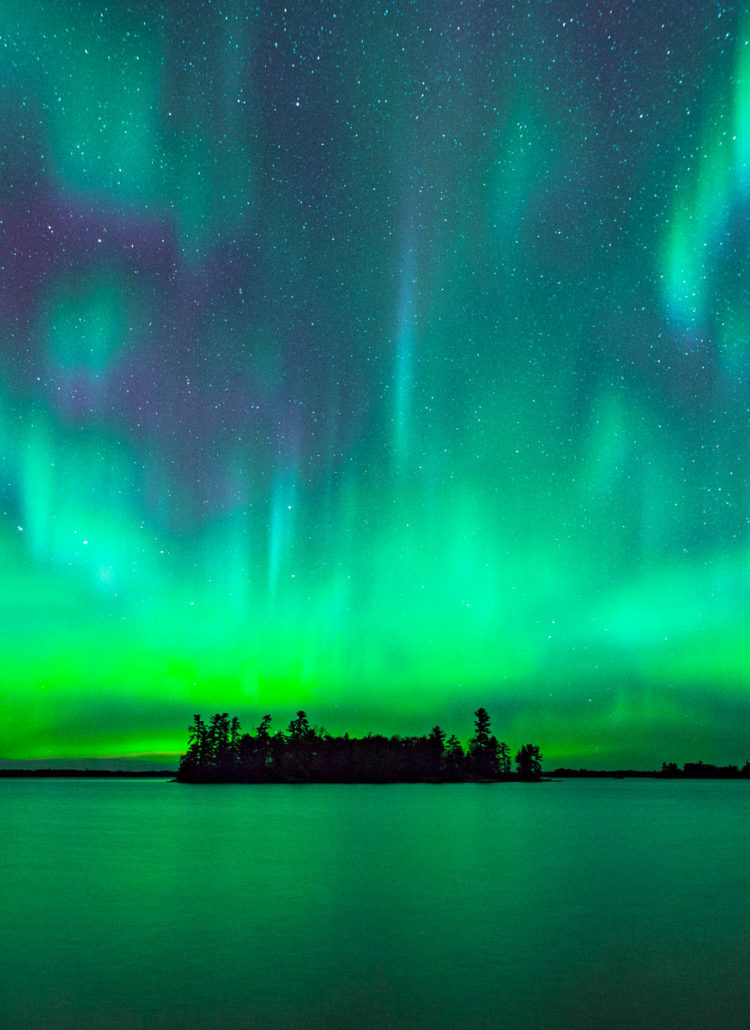

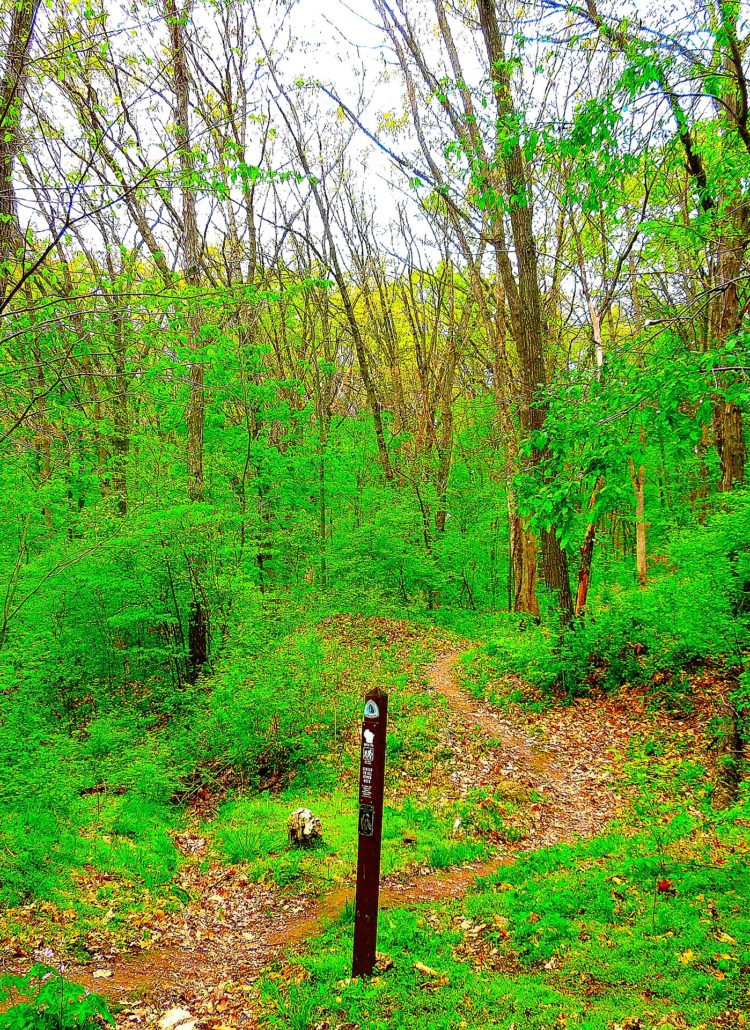
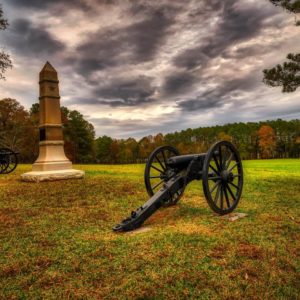

Leave a Reply